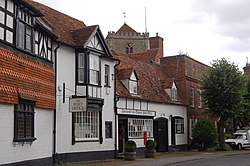Top Qs
Timeline
Chat
Perspective
Dorchester on Thames
Village in Oxfordshire, England From Wikipedia, the free encyclopedia
Remove ads
Dorchester on Thames is a historic village and civil parish in South Oxfordshire, Oxfordshire, England, located about 9 miles (14 km) southeast of Oxford at the confluence of the River Thames and River Thame.
The village has evidence of prehistoric and Roman settlement and rose to prominence in the 7th century when Birinus established a bishopric there. It is best known for Dorchester Abbey, a former cathedral and now a parish church with significant Norman and Gothic architecture.
Today, Dorchester is noted for its historic character, riverside setting, and role in religious and early English history.
Remove ads
Etymology
The name Dorchester is shared with the larger town of Dorchester in Dorset, though no direct historical link between the two place names has been established. The name is believed to derive from a combination of a Celtic or Pre-Celtic element *-Dor* and the Old English suffix *-chester*, meaning "Roman town" or "fort" (from Latin castra).
Dorchester on Thames is situated on a peninsula surrounded on three sides by water, possibly at a point where the river became navigable. This geographic context supports the hypothesis that the prefix *Dor-* relates to the Common Brittonic word for water, *dwfr* (Welsh: *dŵr*), suggesting a meaning along the lines of "fort on the water" or "water town".
This etymology was noted as early as the 16th century by the antiquary John Leland, who in his poem Cygnea Cantio ("Song of the Swan") referred to the settlement by the Greek term Hydropolis ("water city").[2]
There is no surviving record of the settlement’s Latin name, and the early medieval historian Bede’s reference to the town as Dorcic lacks corroboration from other sources.[3]
Remove ads
History
Summarize
Perspective
The area has been inhabited since at least the Neolithic. In the north of the parish there was a Neolithic sacred site, now largely destroyed by gravel pits. On one of the Sinodun Hills on the opposite side of the Thames, a ramparted settlement was inhabited during the Bronze Age and Iron Age. Two of the Sinodun Hills bear distinctive landmarks of mature trees called Wittenham Clumps. Adjacent to the village is Dyke Hills which is the remains of an Iron Age hill fort. The Romans built a vicus[4] here, with a road linking the settlement to a military camp at Alchester, 16 miles (25 km) to the north.[5]
In 634 Pope Honorius I sent a bishop called Birinus to convert the Saxons of the Thames Valley to Christianity. King Cynegils of Wessex gave Dorchester to Birinus as the seat of a new Diocese of Dorchester under a Bishop of Dorchester; the diocese was extremely large, and covered most of Wessex and Mercia. The settled nature of the bishopric made Dorchester in a sense the de facto capital of Wessex, which was later to become the dominant kingdom in England. Eventually Winchester displaced it, with the bishopric being transferred there in 660.
Briefly in the late 670s Dorchester was once more a bishop's seat under Mercian control.[6] Dorchester again became the seat of a bishop in around 875, when the Mercian Bishop of Leicester transferred his seat there. The diocese merged with that of Lindsey in 971; the bishop's seat was moved to Lincoln in 1085. In the 12th century the church, then Dorchester Abbey, was enlarged to serve a community of Augustinian canons. King Henry VIII dissolved the Abbey in 1536, leaving the small village with a huge parish church.
Since 1939 the title of Bishop of Dorchester was revived as a Suffragan Bishop in the Diocese of Oxford.
Remove ads
Amenities
Dorchester Abbey[7] is both the village's Church of England parish church and its main tourist attraction. The Abbey has a museum.[8] Of the ten original coaching inns, two remain: The George[9] and The White Hart.[10] The George has a galleried yard dating back to 1495 and it used to serve coaches on the Gloucester-Oxford-London route.[11] The George was used as a filming location for ITV's Agatha Christie's Poirot in the episode Taken at the Flood in 2006.[12]

Bishop's Court Farm offers alpaca walking, a café, a livery yard, and mooring on the Thames, as well as lambing events in the spring.[13] The farm also holds regular jazz events, contributing to the village's cultural life.[14]
Festivals and events
Dorchester on Thames is the home of a number of annual events:
- The biennial Dorchester on Thames Festival, a 10-day fundraising event held every other May[15]
- The English Music Festival holds its primary concerts at Dorchester Abbey[16]
Nearby is Day's Lock on the Thames, where an annual "World Poohsticks Championship" was previously held.
Notable people
- St Birinus (died c. 650) – 7th-century missionary bishop credited with converting the Kingdom of Wessex to Christianity; established the Christian church at Dorchester-on-Thames and is considered the patron saint of Oxfordshire.
- Robert Brydges Addison (1854–1920) – composer, choirmaster, and teacher.
- Jonty Hearnden (born 1960) – auctioneer, antiques expert, and television presenter who owned a shop and residence in Dorchester-on-Thames.
- Mark Wright (footballer, born 1963) – former professional footballer and England captain, born in Dorchester-on-Thames.
Remove ads
References
Sources
External links
Wikiwand - on
Seamless Wikipedia browsing. On steroids.
Remove ads


